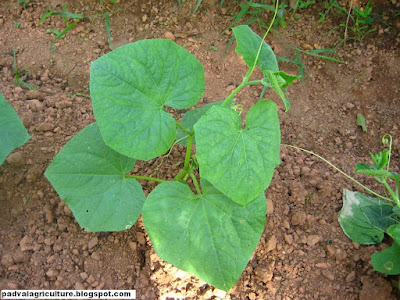 Cucumber (Cucumis sativus) is one of the most widely used salad crops grown both in North and South India. Fruits contain good amount of Iron and Vitamin C along with carbohydrates. It is highly recommended for people suffering from Jaundice, constipation and indigestion
Cucumber (Cucumis sativus) is one of the most widely used salad crops grown both in North and South India. Fruits contain good amount of Iron and Vitamin C along with carbohydrates. It is highly recommended for people suffering from Jaundice, constipation and indigestionLAND PREPARATION
since i am mentioning the monsoon cultivation techniques here, the land preparation is very similar to my other posts where i have mentioned monsoon cultivation. Some main points to begin with
- The land selected must have adequate drainage
- water logging areas should not be selected
- however if availability of land is a constraint, seeds have to be sown on elevated bunds as shown below
- Due to heavy rains, most of the seeds get drowned with too much moisture and they start to rot even before germination, hence more seeds have to be sowed.
- bunds or raised seed beds should have a minimum height of 10 to 15 inches and seeds once germinated must be thinned out and plant distance maintained
 germination seen 7 to 10 days after sowing
germination seen 7 to 10 days after sowing
 close up of germinated seedling
close up of germinated seedling seedling reaches 3 leaf stage in the 3rd week of sowing
seedling reaches 3 leaf stage in the 3rd week of sowing the above pic shows water severely logged in the field. the raised seedling bed literally saved the seedlings from rot and drowing.
the above pic shows water severely logged in the field. the raised seedling bed literally saved the seedlings from rot and drowing.  the photo above shows considerable growth and development of the plant when rainfall recedes and light intensity increases
the photo above shows considerable growth and development of the plant when rainfall recedes and light intensity increases excess plants must be thinned out and plant distance must be maintained as seen above
excess plants must be thinned out and plant distance must be maintained as seen above INTER CULTURE OPERATIONS AND IRRIGATION
INTER CULTURE OPERATIONS AND IRRIGATION- Since this is monsoon technique, irrigation is not given, however, due to erratic rainfall patterns, lite irrigation is a must at the time of sowing to moisten the field in case rains fail.
- while making the raised beds/bunds, decomposed Organic Manure must be added to the soil, and mixed thoroughly and seeds must be sowed on top of this. When the seeds germinate and grow, they will make use of the nutrients present in the soil
- DO NOT spray the crops during monsoons using pesticides or liquid fertilizers when there is not enough sunlight.
- Spraying of Liquid fertilizers should be done only when required and in the presence of sunlight. plants prepare their own food during photosynthesis and so sunlight is the most important factor.
- Soil aeration can be increased by loosening the soil around the root zone of the plants. this also helps in drainage.
 the above figure shows rapid development of the plant and tendril stage
the above figure shows rapid development of the plant and tendril stage soil loosened to provide good aeration and also allow better drainage
soil loosened to provide good aeration and also allow better drainageMANURING, FLOWERING AND HARVESTING
- The plant receives the basal dose of decomposed farm yard manure at the time of preparation of the land and sowing.
- Spray 1 ml seed weed based algae Organic Manure in 1 litre of water at every 10 day intervals. addition of wetting agent like APSA or other sticking agents is recommended so as to increase the effectiveness of the sprays
- Flowering will be seen 40 to 45 days after sowing and the mature fruits can be harvested after 55 to 60 days after sowing.
- Timely harvesting the fruit is a must otherwise they over ripe and become unfit for consumption. for salads, the green color of the fruit must not turn brownish yellow.
- fruits must be plucked every alternate days to avoid over riping
- for seeds, yellow brown fruits , golden fruits (mature color) are harvested, seeds extracted, washed thoroughly in water and dried
- the seeds thhus obtained must be sowed again within 3 to 6 months or it looses its viability
- Cucumber yields up to 100 quintals per hectare
 the above pic shows the same stretch of land with excellent growth and flowering
the above pic shows the same stretch of land with excellent growth and flowering

 formation of tender fruit buds
formation of tender fruit buds growing tender fruit
growing tender fruit mature fruit ready for harvest
mature fruit ready for harvestPESTS , DISEASES AND CONTROL
- I only recommend the usage of pure neem oil @ 5 ml per litre of water to be sprayed only when insect attack is seen
- Imidochloprid systemic insecticide @2 ml in 5 litre water can be used every 10 days for the young seedlings since they are most vulnerable to sucking pests like aphids, thrips and plant minors. it is also effective in controlling red pumpkin beetle which damages the growing leaves and severely injures the plant
- Spraying must be done in sunny weather and not in gloomy weather
- spraying in the evenings from 4pm to 5 pm is recommended than spraying during day time as it will affect pollination
- adding 2 ml per litre sticking agents or wetting agents is required to increase the effectiveness of the sprays
all photos and data by Pritham D'Souza